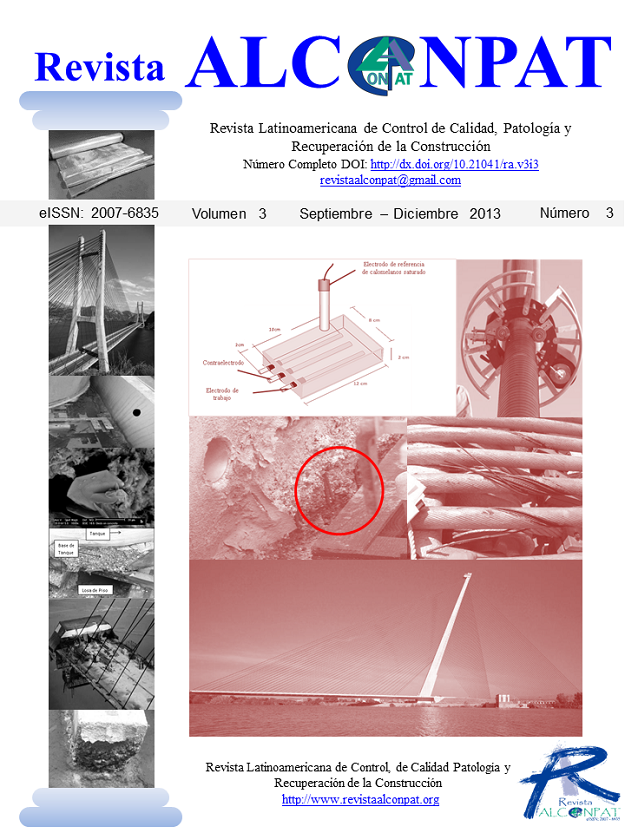Evaluación mecánica de concreto y de corrosión en mortero con partículas de neumático reciclado
DOI:
https://doi.org/10.21041/ra.v3i3.54Keywords:
Concrete, mortar, recycled tire, corrosion rate, and mechanical properties.Abstract
The feasibility of using scrap tire particles in the elaboration of concrete and mortar was investigated. To assess the mechanical properties of hardened concrete, tests evaluating of its density, modulus elasticity and compression strength were undertaken. To determine the workability of freshly made concrete, a slump test was also performed. Tests in which 5, 7.5 and 10% of sand were substituted by recycled tire particles were made. The likelihood of corrosion on the steel is determined, using the technique of corrosion potential. To test the velocity of corrosion was used the linear polarization resistance method (LPR method) was utilized under the same conditions as well as fabrication of concrete. It was observed that using 7.5% of recycled tire particles offers satisfactory results in structures of moderate strength and lighter weight located in environments with chlorides.
Keywords: Concrete, mortar, recycled tire, corrosion rate, and mechanical properties.
Downloads
References
Angst U., Elsener B., Larsen C., and Vennesland O. (2009), “Critical Chloride Content in Reinforced Concrete — A Review.” Cement and Concrete Research 39 (12) (December): 1122– 1138. DOI: https://doi.org/10.1016/j.cemconres.2009.08.006
Bravo M., and Brito J. (2012), “Concrete Made with Used Tyre Aggregate : Durability-related Performance.” Journal of Cleaner Production 25: 42–50. DOI: https://doi.org/10.1016/j.jclepro.2011.11.066
IMCYC. 1993. Proporcionamiento De Mezclas. México: Instituto Mexicano del Cemento y del Concreto, A.C.
Li-Cheng L., Chui-Te C. (2007), “A Laboratory Study on Stone Matrix Asphalt Using Ground Tire Rubber.” Construction and Building Materials 21 (5) (May): 1027–1033. DOI: https://doi.org/10.1016/j.conbuildmat.2006.02.005
Li G., Stubblefield M., Garrick G., Eggers J., Abadie C., and Huang B. (2004), “Development of Waste Tire Modified Concrete.” Cement and Concrete Research 34 (12) (December): 2283–2289. DOI: https://doi.org/10.1016/j.cemconres.2004.04.013
Ling T. (2012), “Effects of Compaction Method and Rubber Content on the Properties of Concrete Paving Blocks.” Construction and Building Materials 28 (1): 164–175. DOI: https://doi.org/10.1016/j.conbuildmat.2011.08.069
Lu C., Jin W., and Liu R. (2011), “Reinforcement Corrosion-induced Cover Cracking and Its Time Prediction for Reinforced Concrete Structures.” Corrosion Science 53 (4) (April): 1337–1347. DOI: https://doi.org/10.1016/j.corsci.2010.12.026
Sten M. and Gary A. (1957), “Electrochemical Polarization No. 1 Theoretical Analysis of the Shape of Polarization Curves.” Journal of the Electrochemical Society: 56-63.
Oikonomou N. and Mavridou S. (2009), “Cement & Concrete Composites Improvement of Chloride Ion Penetration Resistance in Cement Mortars Modified with Rubber from Worn Automobile Tires.” Cement and Concrete Composites 31 (6): 403–407. DOI: https://doi.org/10.1016/j.cemconcomp.2009.04.004
Pelisser F., Zavarise N., Arent T., and Michael A. (2011), “Concrete Made with Recycled Tire Rubber : Effect of Alkaline Activation and Silica Fume Addition.” Journal of Cleaner Production 19 (6-7): 757–763. DOI: https://doi.org/10.1016/j.jclepro.2010.11.014
Rodriguez S. (2005), “Efectos De Una Estracción Electroquimica De Cloruros Sobre El Concreto Armado.” Universidad Autónoma de San Luis Potosí.
Sang K, Hajirasouliha I., and Pilakoutas K. (2011), “Strength and Deformability of Waste Tyre Rubber-filled Reinforced Concrete Columns.” Construction and Building Materials 25 (1): 218–226. DOI: https://doi.org/10.1016/j.conbuildmat.2010.06.035
Song Y., Song L., and Zhao G. (2004), “Factors Affecting Corrosion and Approaches for Improving Durability of Ocean Reinforced Concrete Structures.” Ocean Engineering 31 (5-6) (April): 779–789. DOI: https://doi.org/10.1016/j.oceaneng.2003.07.006
Toutanji H A. (1996), “The Use of Rubber Tire Particles in Concrete to Replace Mineral Aggregates.” Cement & Concrete Composites 18 (95): 135–139. DOI: https://doi.org/10.1016/0958-9465(95)00010-0
Yung W., Yung L. C., and Hua L. (2013), “A Study of the Durability Properties of Waste Tire Rubber Applied to Self-compacting Concrete.” Construction and Building Materials 41 (April): 665–672 DOI: https://doi.org/10.1016/j.conbuildmat.2012.11.019
Downloads
Published
How to Cite
Issue
Section
License
_______________________________
License in effect from September 2020
You are free to:
- Share — copy and redistribute the material in any medium or format for any purpose, even commercially.
- Adapt — remix, transform, and build upon the material for any purpose, even commercially.
- The licensor cannot revoke these freedoms as long as you follow the license terms.
Under the following terms:
- Attribution — You must give appropriate credit , provide a link to the license, and indicate if changes were made . You may do so in any reasonable manner, but not in any way that suggests the licensor endorses you or your use.
- No additional restrictions — You may not apply legal terms or technological measures that legally restrict others from doing anything the license permits.
Notices:
You do not have to comply with the license for elements of the material in the public domain or where your use is permitted by an applicable exception or limitation .
No warranties are given. The license may not give you all of the permissions necessary for your intended use. For example, other rights such as publicity, privacy, or moral rights may limit how you use the material.





















.png)














